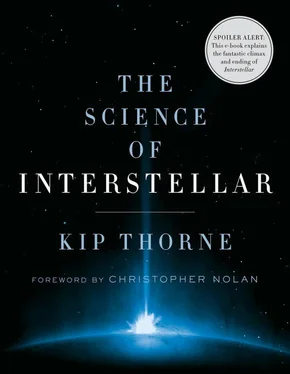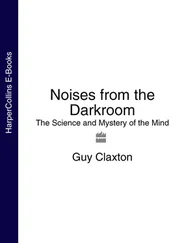One day in 2019, LIGO was hit by a burst of gravitational waves far stronger than any ever before seen (Figure 16.2). The waves oscillated with an amplitude that grew and fell several times, and then cut off suddenly. The entire burst lasted for only a few seconds.
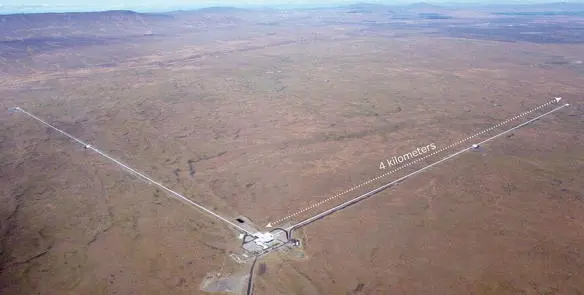
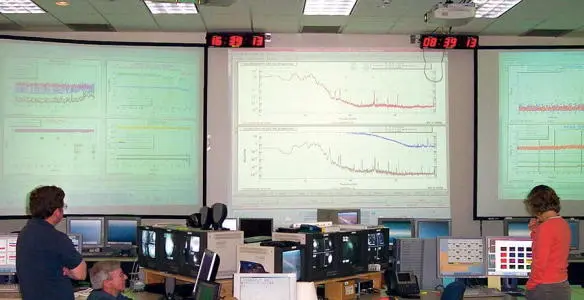
Fig. 16.1. Top : Aerial photograph of the LIGO gravitational wave detector at Hanford, Washington. Bottom : The LIGO control room where the detector is controlled and its signals are monitored.
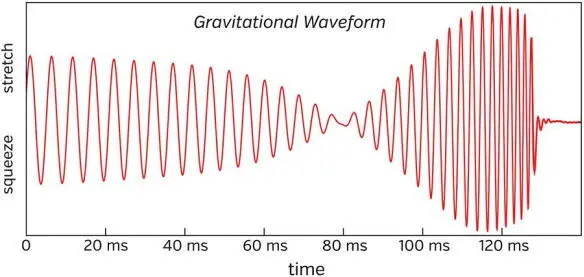
Fig. 16.2. The last 120 milliseconds (ms) of the gravitational waveform discovered by LIGO. [Drawing by Kip based on simulations by Yanbei Chen and by Foucart et al. (2011).]
By comparing the waves’ shape (their “waveform”; Figure 16.2) with simulations performed on supercomputers, Professor Brand and his team deduced their source.
Neutron Star Orbiting a Black Hole
A neutron star, orbiting around a black hole, had emitted the waves. The star weighed 1.5 times as much as the Sun, the hole weighed 4.5 times the Sun, and the hole was spinning rapidly. The spin dragged space into motion, and the space whirl grabbed the star’s orbit, forcing it to precess slowly, like a tilted top. The precession modulated the waves, causing them to rise and fall in amplitude (Figure 16.2).
The waves traveled out through the universe, carrying away energy (Figure 16.3). With its energy gradually decreasing, the star gradually spiraled inward toward the black hole. When the distance between the star and the hole had shrunk to 30 kilometers, the hole’s tidal gravity began tearing the star apart. Ninety-seven percent of the stellar debris was swallowed by the black hole, and 3 percent was thrown outward, forming a tail of hot gas that the hole then sucked back inward to form an accretion disk.
Figure 16.4 shows a computer simulation of the last few milliseconds of the star’s life. At ten milliseconds before the end, the black hole is spinning around the red-arrowed axis, and the star is orbiting around the picture’s vertical axis. At four milliseconds the hole’s tendex lines are stretching the star apart. At two milliseconds, the hole’s whirling space has thrown the stellar debris up into the hole’s equatorial plane. At zero milliseconds, the debris is beginning to form an accretion disk.
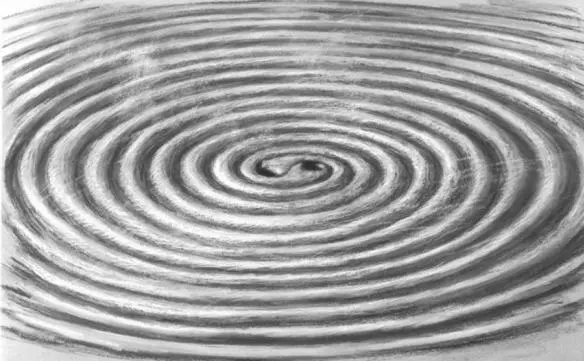
Fig. 16.3. Gravitational waves flowing out from the orbiting star and hole, as seen from the bulk. [Drawing by LIGO Laboratory artist based on my hand sketch.]

Fig. 16.4. Computer simulation of the last few milliseconds of the neutron star’s life. [From a simulation by Francois Foucart, and colleagues. See http://www.black-holes.org/.]
Looking back through LIGO’s data for the preceding two years, Professor Brand and his team discovered very weak waves emitted by the neutron star. The star had a tiny mountain, a centimeter high and a few kilometers wide (such mountains are thought likely). As the mountain was carried around and around by the star’s rotation, it produced waves that oscillated weakly but steadily, day after day after day.
By analyzing these steady waves with care, Professor Brand learned the direction to their source. The direction was unbelievable! The waves were coming from something in orbit around Saturn. As the Earth and Saturn moved in their orbits, the source was always near Saturn!
A neutron star orbiting Saturn? Impossible! A black hole accompanying the neutron star, with both orbiting Saturn? Even more impossible! Saturn would long ago have been destroyed, and the star’s and hole’s gravity would long ago have disrupted the orbits of all the Sun’s planets, including Earth. With disrupted orbit, the Earth would have been carried close to the Sun and then far away. We would have been fried, frozen, and killed.
But there the waves were. Unequivocally emerging from near Saturn.
Professor Brand could find only one explanation: The waves must emerge from a wormhole that orbits Saturn. And their source, the black hole and neutron star, must be on the other end of the wormhole (Figure 16.5). The waves traveled outward from the star and hole. Small portions of the waves were captured by the wormhole, traveled through it, and then spread outward through the solar system with a small portion reaching Earth and passing through the LIGO gravitational wave detector.

Fig. 16.5. Gravitational waves travel through the wormhole to Earth.
Origin of This Story
A brief variant of this story was in the original 2006 treatment for Interstellar that Lynda Obst and I wrote. However, gravitational waves did not play a significant role in the rest of our treatment, nor in the subsequent screenplay that Jonathan Nolan wrote and Chris rewrote. And even without gravitational waves, the amount of serious science in the movie was enormous. So when Chris sought ways to simplify Interstellar ’s rich panoply of science, gravitational waves were a natural candidate for the ax. He jettisoned them.
For me, personally, Chris’s decision was painful. I cofounded the LIGO Project in 1983 (together with Rainer Weiss at MIT and Ronald Drever at Caltech). I formulated LIGO’s scientific vision, and I spent two decades working hard to help make it a reality. And LIGO today is nearing maturity, with the first detection of gravitational waves expected in this decade.
But Chris’s reasons to jettison gravitational waves were compelling, so I didn’t utter even a whisper of protest.
Gravitational Waves and Their Detectors
I indulge myself and tell you a bit more about gravitational waves before moving back to Interstellar.
Figure 16.6 is an artist’s conception of some tendex lines emerging from two black holes that orbit each other counterclockwise, and collide. Recall that tendex lines produce tidal gravity (Chapter 4). The lines emerging from the holes’ ends stretch everything they encounter, including the artist’s friend, whom she has placed there. The lines emerging from the collision region squeeze everything they encounter. As the holes orbit around each other, they drag their tendex lines around, splaying outward and backward, like water from a whirling sprinkler.
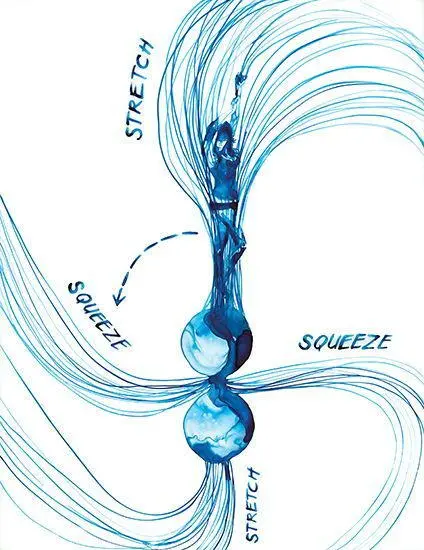
Fig. 16.6. Tendex lines from two black holes that collide while orbiting each other counterclockwise. [Painting by Lia Halloran.]
The holes merge to form a single, larger black hole that is deformed and spinning counterclockwise, and that drags its tendex lines around and around. The tendex lines travel outward, like water from the sprinkler, creating the intricate pattern that I show in Figure 16.7. The red lines stretch. The blue lines squeeze.
Читать дальше
